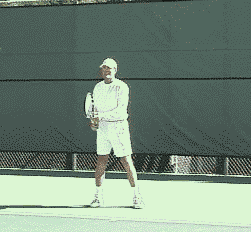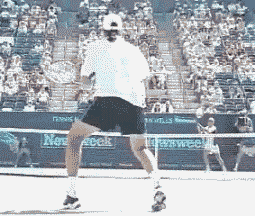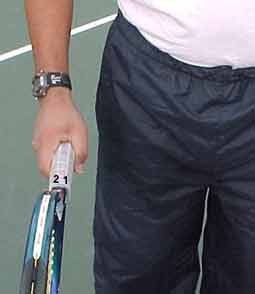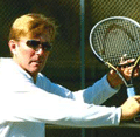Private Lessons:
The Slice or Underspin Backhand
Scott Murphy

Despite the great emphasis today on the topspin power game, the fact remains having a slice backhand is an absolute must, whether you hit your backhand with one hand or two.
The use of underspin is multi-faceted: for groundstrokes, return of serve, approach shots, half volleys, and volleys. Patrick Rafter is an example of a player who may use all of these possibilities in a single point. Andre Agassi may hit two-handers for 90 percent of a match, but suddenly call on the slice backhand in a given situation. Then there's the great Steffi Graf who hit virtually all of her backhands with underspin.
You can't be a complete player or a successful competitor without it. In match play you need slice in a wide variety of situations: to neutralize a heavy topspin shot, to mix up the pace of a rally, to keep the ball low, to buy time on defense, and play balls that are low, high, wide, or short. (It's worthwhile mentioning that some tennis pundits prefer to call slice, "underspin" because in the literal sense a sliced ball curves. However I think for most people the shots are considered one in the same and in this article I'll use the terms interchangeably).

Initial Difficulty
Although developing this shot is critical, it has been my experience over the years that the vast majority of players find the slice backhand to be difficult initially and have to be encouraged to stick with the shot, practicing its essential elements repeatedly until they become more familiar.
Before covering those elements I'd like to dispel a couple of common misconceptions about this shot. First, a good slice backhand is neither "chopped" nor "scooped." Trying to use these motions can put the ball in the bottom of the net or cause it to pop up and float.
The best slice backhands are actually drives that can be hit with varying degrees of underspin, and we'll present the proper swing trajectory to allow you to do this.
Grip
The Continental grip is almost universally considered the best grip to hit slice. This is because the continental allows the player to open the racquet face more naturally.

With some students, learning the continental can become a real bone of contention, usually because they are not using it effectively in other aspects of their game, such as the serve or the volleys. Trying to learn the slice, players have a tendency to quickly switch back to their old backhand grips. For a one-hander, this is the full eastern backhand. For a two-hander, it's usually a right-handed forehand grip.
While it is possible to hit a version of the slice with a full (or strong) backhand grip, players who don't shift to the continental ultimately work a lot harder to do so. This is because, with the stronger grip, it's much harder to get the leading edge of the racquet on the outside of the ball. The result, typically, is a ball with too much sidespin that is also much harder to direct, and sacrifices pace. At the other extreme, trying to slice with a forehand grip will cause the ball to float, as well as create possible stress on the wrist.
Granted, if you haven't used it before, the first attempts with a Continental grip can be very disorienting. But with a real understanding of what makes it work and lots of repetition, this shot will eventually become very comfortable. In fact many experienced players think it's the most natural and flowing stroke in the game.
Preparation Phase
As with all other shots, start by making sure you use your eyes effectively. The earlier you see the ball off your opponent's racquet the sooner you'll be able to determine if your reply needs to be hit with slice, and the more quickly you'll be able to get into position to hit it.

Make a ready hop just before your opponent hits the ball and when you see the ball moving toward your backhand, step to the side with the foot nearest the ball and begin to rotate your hips and shoulders. Create a full coil by keeping your head and shoulders level and connecting the hitting shoulder with your chin. Be sure to keep your eyes on the incoming ball.
On the backswing, your hitting arm should bend to about a 45-degree angle. If you bend your arm much more than that you risk a late hit or a choppy swing. The racquet head should be just a little above the plane of the incoming ball, higher or lower depending on the actual height of the particular shot.
To facilitate the change of grip and provide support, your non-racquet hand should be on the throat of the racquet during the entire backswing.
At the completion of the backswing, the wrist should be set at a 45-degree angle relative to the forearm. The racquet face is now open with the edges of the racquet more or less even.
This is very important. The inside edge of the racquet is the one closest to the ear. The outside or "leading edge" is the one that moves toward the ball first. If the outside edge is much lower than the inside edge at completion of the backswing (as in the topspin backhand), this indicates that the backhand grip is too strong or the wrist position is poor.
Go to Page 2

Scott Murphy is from Marin County, California where he started playing tennis at age 5 in a family of tennis nuts. Both of his parents were major influences in his development. He also took lessons from Marin legend Hal Wagner and former top 10, Harry Roach. Scott is a graduate of the University of California at Berkeley where he played baseball and football but continued to work on his tennis game with renowned coach Chet Murphy. He was the head pro at San Domenico/Sleepy Hollow Tennis Club for over 20 years. He also directed the Nike Tahoe Tennis Camp at the Granlibakken Resort for 10 years. Scott now teaches privately in Ross, Marin County and in the summer he directs the Tuscan Tennis Academy which he founded in Quarrata, Italy.
Check out Scott's website at scottmurphytennis.net
You can contact Scott directly at: scottmrph@yahoo.com
|



